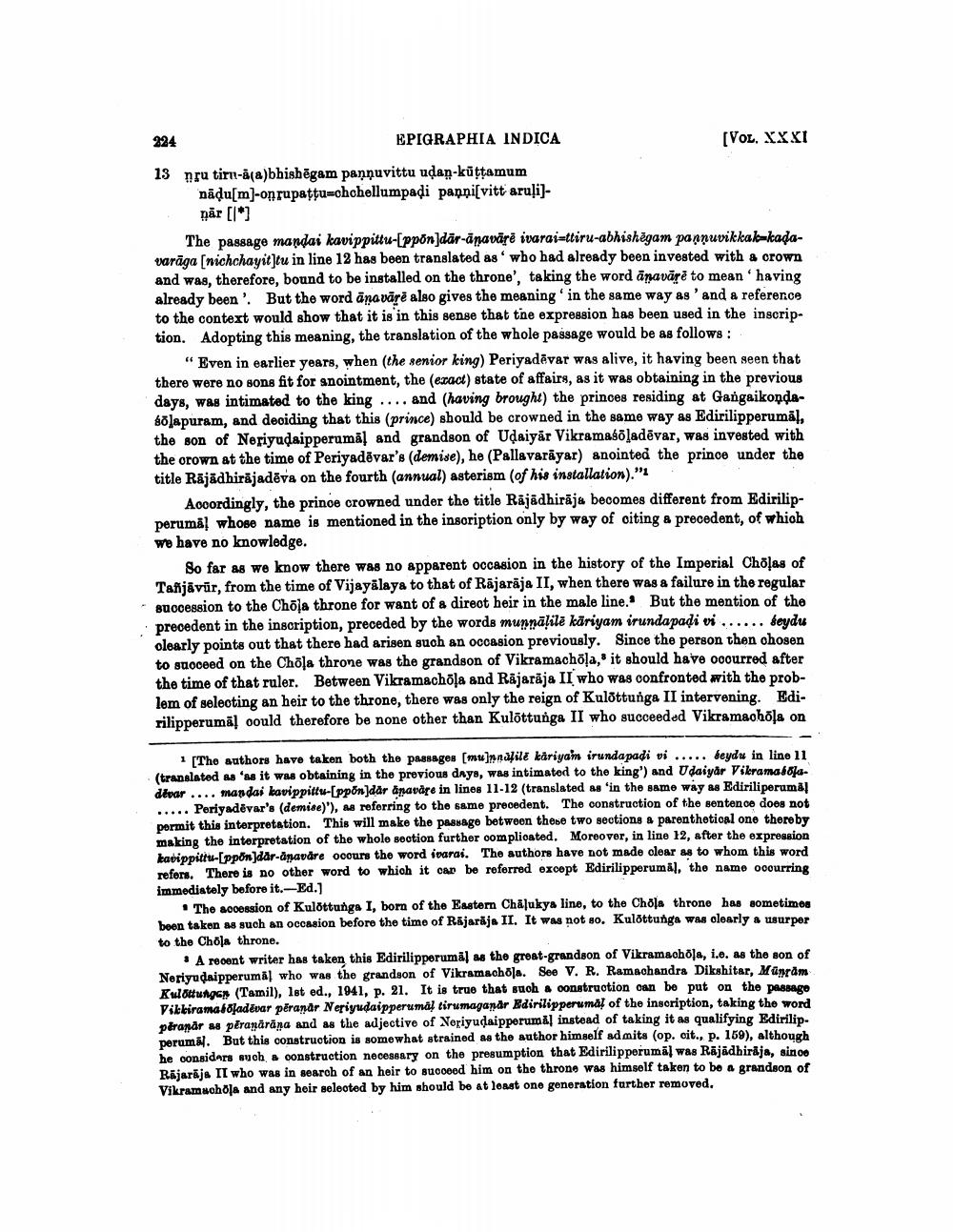________________
224 EPIGRAPHIA INDICA
(VOL. XXXI 13 nru tirn-(a)bhishēgam paņņuvittu udan-küttamum
nādu[m]-onrupațţu=chchellumpadi panni[vitt aruļi)
nār [l*]
The passage mandai kavippittu-ppon]där änavārë ivaraittiru-abhishëgam pannuvikkak-kadavarāga (nichchayittu in line 12 has been translated as' who had already been invested with a crown and was therefore, bound to be installed on the throne', taking the word änavāre to mean'having already been'. But the word änavāre also gives the meaning in the same way as 'and a reference to the context would show that it is in this sense that the expression has been used in the inscription. Adopting this meaning, the translation of the whole passage would be as follows:
"Even in earlier years, when the senior king) Periyadēvar was alive, it having been seen that there were no sons fit for anointment, the (exact) state of affairs, as it was obtaining in the previous days, was intimated to the king .... and (having brought) the princes residing at GangaikondaSolapuram, and deciding that this (prince) should be crowned in the same way as Edirilipperumal. the son of Neriyudaipperumal and grandson of Udaiyar Vikramasöladēvar, was invested with the crown at the time of Periyadēvar's (demise), he (Pallavarāyar) anointed the prince under the title Rājādhirajadēva on the fourth (annual) asterism (of his installation).":
Accordingly, the prince crowned under the title Räjādhirāja becomes different from Edirilipperuma! whose name is mentioned in the inscription only by way of oiting a precedent, of which we have no knowledge.
So far as we know there was no apparent occasion in the history of the Imperial Chöļas of Taħjāvūr, from the time of Vijayalaya to that of Rājarāja II, when there was a failure in the regular Buccession to the Chola throne for want of a direot heir in the male line. But the mention of the precedent in the inscription, preceded by the words munnāļile käriyam irundapadi vi ...... beydu olearly points out that there had arisen such an occasion previously. Since the person then chosen to suoceed on the Chola throne was the grandson of Vikramachöļa, it should have ooourred after the time of that ruler. Between Vikramachöļa and Rajarāja II who was confronted with the problem of selecting an heir to the throne, there was only the reign of Kulottunga II intervening. Edirilipperumā! oould therefore be none other than Kulõttunga II who succeeded Vikramachõla on
1 [The authors have taken both the passages [mu] file kariyamn irunda padi vi ..... beydu in line 11 (translated as 'as it was obtaining in the previous days, was intimated to the king') and Udaiyar Vikramad8fadivar .... mandai kavippittu-(ppon]där änavåre in lines 11-12 (translated as 'in the same way as Ediriliperamal ..... Periyadëvar's (demise)'), se referring to the same precedent. The construction of the sentence does not permit this interpretation. This will make the passage between these two sections a parenthetical one thereby making the interpretation of the whole seotion further complicated. Moreover, in line 12, after the expression kavippittu-ppon ]dar-anavare ooours the word ivarai. The authors have not made clear as to whom this word refors. There is no other word to which it can be referred except Edirilipperumal, the name ooourring immediately before it.-Ed.]
The accession of Kulottunga I, born of the Eastern Chalukys line, to the Chola throne has sometimes been taken as such an occasion before the time of Rajarăjs II. It was not so. Kulottunga was clearly a usurper to the Chola throne.
• A recent writer has taken this Edirilipporumā) as the great-grandson of Vikramachola, i.e. as the son of Noriyadaipperumal who was the grandson of Vikramachóla. See V. R. Ramachandra Dikshitar, Münram Kulttunge (Tamil), 1st ed., 1941, p. 21. It is true that such a construction can be put on the passage Viktiramaboladevar pērañar Neriyudaipperumal tirumaganar Edirilipperumal of the inscription, taking the word përanar as pērapärana and as the adjective of Noriyudaipperumal instead of taking it as qualifying Edirilipperumal. But this construction is somewhat strained as the author himself admits (op. cit., p. 169), although he considers such a construction necessary on the presumption that Edirilipporumal was Rajadhiraja, sinoo Rajarāja II who was in search of an heir to succeed him on the throne was himself taken to be a grandson of Vikramsohla and any hoir selooted by him should be at least one generation further removed.




